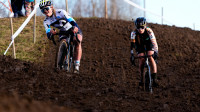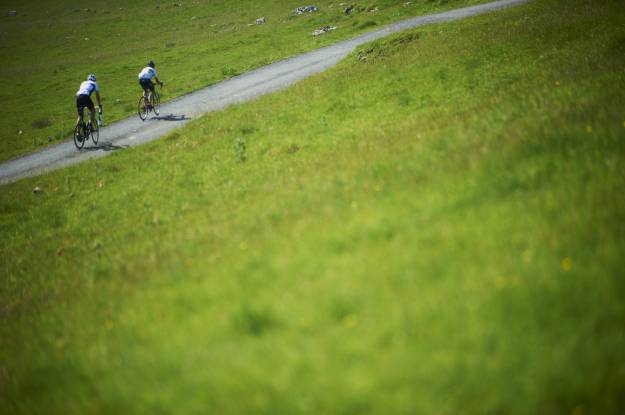Knowledge Level: Beginner
All the British Cycling Training Plans use heart rate or power zones to specify the intensity at which you should be riding during the workouts. In this series of four articles, we’ll examine all aspects of intensity and why objectively monitoring it is fundamental to cycling success.
In this first article we’ll look at why you should monitor intensity, how it applies to many aspects of riding and how training zones are established.
Isn’t it just for top riders?
Many riders, both novice and experienced, make the mistake of thinking that monitoring their riding intensity using heart rate or power is taking their riding too seriously, should be left to the pros and surely, cycling is just cycling. However, almost all cyclists would benefit from learning to monitor intensity objectively and, with heart rate monitors now affordable to all, there are really no reasons not to.
With work, family and other commitments outside of cycling pressing your time on the bike, making the most of your valuable training time is essential. Understanding and monitoring intensity guarantees that you’ll be making the most of the time you do get to ride and maximising your fitness gains.
The simplest way to monitor intensity is to use self perceived exertion. There are a number of scales, such as the Borg scale, which score how hard you perceive an effort to be. Physical cues such as breathing rate, ability to talk and sensations in your legs are often used to assign scores.
Although many people find the simplicity and zero cost of using perceived exertion appealing, it’s not an especially accurate or objective way to monitor intensity. For example, on a long ride, a climb early on during a ride could feel relatively easy but, later on during the same ride, with some fatigue in your legs, a similar climb ridden at a similar pace, could feel much harder. Using heart rate or power, your training zones would allow you to pace the ride more evenly, pushing less hard on the earlier climb and having more in reserve for the later one.
Intensity for pacing
Having accurately assigned heart rate or power training zones and applying them to your riding allows you to pace long training rides or sportives. They’ll prevent you from going too hard early on and allow you to gauge your effort on climbs. You’ll be able to ride at a more even effort overall, the best way for you to attain the fastest time for your riding ability.
Intensity for training
During training sessions on the road or the indoor trainer, heart rate or power targets are given for specific work periods, often known as intervals. By hitting these intensity targets, you can be sure you’re achieving the objectives of the workout, targeting the correct physiological system and getting the most from the session.
Avoiding overtraining
The classic mistake that most riders who don’t objectively monitor their riding intensity make is to go too hard when they should be riding easy and riding too slow when they should be pushing hard. They end up spending almost all their time in a “physiological no-man’s land” which doesn’t stimulate training gains, limits the opportunity for recovery and accumulates fatigue. They’ll often try to progress their training by simply increasing mileage or time spent riding but this is a guaranteed recipe for staleness and, if continued, overtraining. By establishing definite intensity goals for each ride and sticking to them, whether strict easy spinning recovery or short but intense intervals, you’ll achieve the fitness gains you’re targeting, maximise the efficiency of your training and avoid accumulating “junk miles”.
The link between intensity and fuelling
On long training rides or events, regular fuelling is essential. The Great Britain Cycling Team nutritionists have written a comprehensive guide to pre, during and post ride nutrition. However, many riders find that they suffer from gastric distress, nausea or bloating and struggle to take on adequate food. One of the primary reasons for this is riding at too high an intensity. If you’re pushing too hard, even marginally, your body will divert blood flow away from your stomach and effectively shut your digestive system down. By monitoring your intensity and sticking to known training zones you can prevent this from happening.
Finding your training zones
Once you have bought your heart rate monitor or power meter, the first step is to establish your training zones. There are a number of formulas, such as 220-age and then using percentage bands from that. Monitors with automatic zone calculation will use a derivative of this type of formula. However these calculations will always yield generic and inaccurate results. Your zones have to be specific to you and your physiology and therefore we recommend testing for functional threshold heart rate (FTHR) or functional threshold power (FTP) and calculating your zones from that.
What is functional threshold?
Functional threshold represents the highest physical intensity that you can sustain for approximately one hour. Many riders think of this as similar to performing a 25-mile time trial effort as this requires a maximal, but evenly distributed effort for the entire distance. If you ride above this functional threshold intensity then fatigue will set in rapidly and your pace will drop significantly. Functional threshold can be thought of as your cycling “red-line” and from this figure highly accurate and personalised training zones can be calculated. As an essential component of all of the British Cycling Training Plans, a full protocol for testing, including a link to a zone calculator, can be found in the supporting documents. Fortunately, as an hour maximal effort is both physiologically and psychologically extremely demanding, accurate results can be extrapolated from a shorter, but still intense, 20-minute effort.
Why use threshold rather than maximum heart rate?
One of the most common questions we’re asked in relation to intensity is why we recommend testing for threshold, rather than maximal, heart rate as a basis for calculating training zones. Simply, after working with numerous riders from complete novices to Olympic Champions, we’ve found it to be far more accurate and reliable. Testing for maximal heart rate is extremely unpleasant, requires high levels of motivation and, the level you can achieve, can easily be affected by fatigue, low level illness or just having an “off-day”. Additionally, riding at threshold will be a far more familiar and relevant effort level to the majority of cyclists than an all-out maximal effort and this makes accurately pacing the test far easier.
In the next article of this series, we’ll look at heart rate training, explain what the different training zones mean and how they apply to your riding.











